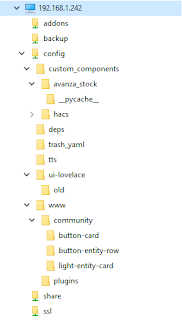I spent quite some time browsing the Internet trying to understand where to start and what to buy to build my home automation system. In short I came to the conclusion that I did not want to limit myself to one technology (z-wave, bluetooth, 433 MHz, zigbee, ...) and not to one vendor. At the same time I did not want to have several different apps and interfaces to control my system.
 |
| Figure 1. Do not shy away from adding multiple gateways and devices to your home automation. |
The solution; multiple hubs to support different vendors and technologies but on system to rule them all. Hass.io! The interface as such is the hass.io web interface when on a computer and the Home Assisistant Companion app when on a portable device.
I am still very happy with my choice. A list of my current hardware and software can be found below.
My gateway hardware
- Raspberry Pi 4, 4 Gb
- Raspberry Pi USB-C power supply
- SanDisk Extreme PRO microSDX card
- Aeotec Z-wave USB stick Gen 5
- Tellstick znet lite v2 (not recommended)
- IKEA trådfri gateway
- Plejd gateway
- USB 2.0 hub (to solve compatibility issue between Raspberry 4 and Aeotec Z-wave stick)
My devices hardware
- Ikea trådfri on/off outlet
- Ikea trådfri bulbs
- Ikea trådfri motion sensor
- Ikea trådfri dimmer
- Telldus temperature and humidity sensor (TS320)
- Telldus on/off outlet (not recommended: never got this working at all)
- Telldus PIR motion sensor (not recommended: intermittent failures)
- Telldus magnet sensor slim (not recommended: intermittent failures)
- Aeotec door and window sensor gen 6
- Aeotec door and window sensor gen 5
- Plejd CTR-01, DIM-01, DIM-02
Hass.io official components (software)
- Samba
- SSH server
- Configuration
- MQTT
Hass.io custom components (software)
- hassio-plejd
- button-card
- slider-entity-row
- lovelace-layout-card
- Västtrafik public transport
- Avanza stock
- Synology NAS
Development software
- Microsoft visual studio code
- Putty
- Notepad++
Mobile apps
- Home assistant companion
Voice control
- Google nest mini
File structure
User interface
 |
| Figure 1. Lovelace dashboard with button-cards. |
 |
| Figure 2. Lovelace lights panel with button-cards. |
 |
| Figure 3. Lovelace scenes panel with button-cards. |
 |
| Figure 4. Lovelace graphs panel. |
 |
| Figure 5. Lovelace status panel. |
Please let me know in the comments field if you have any questions or comments.







I really inspired and have tons of questions.
ReplyDeleteStart asking and I will try to answer what I can!
DeleteI get not wanting to limit to one technology, but on the other hand picking a lot of completely different technologies for the same purpose (so mixing 433 mhz and zigbee and z-wave motion sensors for example) also has it's limits, and adds complexity, even with hass... It also limits what you can do to make the system robust when hass goes down (eg the computer fails, a stick or hub fails) where staying more inside of one ecosystem you can do some direct "emergency"-couplings (like a zwave switch that is also directly associated with a lamp so you can still turn on a basic light when there is a problem with hass). I'm mainly looking into zwave (as it seems to havet he least compatibility problems when mixing vendors), but doubting to add zigbee for the lights (because for lights the zigbee ecosystem is much larger). However, zigbee/tradfri seems to have almost no switches that are mains powered instead of battery powered :-( And i seen o reason to put battery devices when I have a perfectly good power line running in that location already...
ReplyDeleteThanks for your feedback.
DeleteI understand your thinking and partly agree. I am still in prototype mode and might settle for fewer systems later on but so far I have not experienced any problems. The compatibility between vendors is mostly handled by hass.io since it deals with the translation between systems.
When it comes to fallback I hope that I can get my hass.io/raspberry system robust enough but all (Plejd, IKEA, Telldus, ...) all have apps I can fall back to if hass.io goes down.
It will be really interesting to see how the industry evolves going forward, the most likely senario after all is that everything I have today will be obsolete in 3-5 years anyways :)